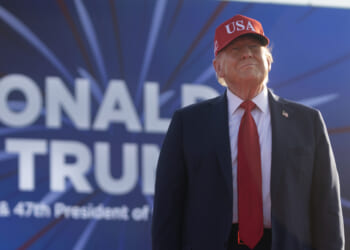The United States is involved to varying degrees in four regional conflicts that have the potential to evolve into a global conflagration. Wars are currently raging in Eastern Europe and the Middle East, India and Pakistan recently clashed, while tensions continue to rise in the Indo-Pacific. The Eurasian landmass is a tinderbox, and it will take prudent statesmanship to avoid setting more of it on fire. Fortunately, the United States has a president whose instincts are to dampen conflicts and mediate geopolitical disputes before they get out of control.
President Donald Trump wants to resolve the “Third World Wars” before they are transformed into the Third World War.
In his brilliant analysis of the Second World War, Victor Davis Hanson showed “how fighting different enemies, alongside disparate allies, in greatly different ways across the globe coalesced into one war.”
The Second World War emerged from a variety of regional conflicts beginning with Japan’s invasion of Manchuria in 1931 and eastern China in 1937; a proxy war between Germany and Soviet Russia in Spain beginning in 1936; Germany’s conquest of Czechoslovakia in 1938; Germany and the Soviet Union’s attack on Poland in September 1939; Britain and France versus Germany in 1939-40; Japan versus the Soviet Union in 1939; the Soviet Union’s war with Finland in 1940, and its occupation of the Baltic states in 1940; Germany’s attack on the Soviet Union in 1941; Japan’s attack upon the United States in December 1941, followed by Britain’s declaration of war against Japan and Germany’s declaration of war against the United States.
“[B]y the end of 1941,” Hanson writes, “something quite cataclysmic followed: all the smaller conflicts compounded unexpectedly into a total, global war.” (RELATED: Who Won World War II?)
The result of the coalescence of the regional wars into a global war between 1931 and 1945 was some 60 million dead; the firebombing of cities; mass starvation; and widespread disease. The global war ended with the dropping of two atomic bombs on Japanese cities, ushering in the nuclear age. No one foresaw this in 1931, and very few appreciated the oncoming catastrophe even as late as 1939. Thucydides noted long ago that war is caused by fear, honor, and interest. Wars tend to get out of hand. As Hanson writes and history confirms, “Starting wars is far easier than ending them.”
In the late 19th century, Germany’s Chancellor Otto von Bismarck once expressed the fear that the next great war would result from some damned foolish thing in the Balkans. He proved to be quite prescient.
The First World War, like the Second World War, started as a series of regional wars in the Balkans, culminating in a war between Austria-Hungary and Serbia in July 1914. The rigid alliance system (and Germany’s war plans) brought Germany into the war on the side of Austria-Hungary, Russia on the side of Serbia, and France on the side of Russia. The prolific British historian Niall Ferguson in The Pity of War wrote that Great Britain was not committed to joining the war by any formal alliance, but its statesmen were drawn in by a misreading of German war aims. Britain’s entry into the war, however, guaranteed that the war would globalize because of Britain’s far-flung empire.
The Russia–Ukraine War is more than three years old, and the casualties are piling up with no end in sight. The U.S. and NATO involvement on the side of Ukraine has enabled Ukraine to continue fighting (including its recent long-range drone strike that destroyed more than 40 Russian strategic bombers), but also threatens to widen the war should Russia strike a NATO country. (RELATED: Putin Caught in an Expanding Spiderweb)
Meanwhile, China, Iran, and North Korea have assisted Russia in its war effort, while America’s key Middle East ally, Israel, has gone to war with Iran, whose leaders have threatened to strike U.S. interests in the region. India, a U.S. ally, and Pakistan, a Chinese ally, have recently renewed their geopolitical conflict over Kashmir. And tensions between the U.S. (and its regional allies Japan, South Korea, the Philippines, Australia) and China continue to rise in the western Pacific as China pledges to reunify Taiwan with the mainland peacefully or by force if necessary. (RELATED: China’s Threat to Taiwan: Intentions and Capabilities)
In the lead-up to the First and Second World Wars, statesmen made decisions based on the Thucydidean calculus of fear, honor, and interest, and hurled the world into global cataclysms. A third such cataclysm would involve perhaps many, if not most, of the world’s nine nuclear powers, who have a combined arsenal of approximately 12,000 nuclear warheads. President Trump’s top foreign policy priority at the moment is to prevent the ongoing regional conflicts from metastasizing across the globe.
READ MORE from Francis P. Sempa:


![Former Bravo Star Charged After Violent Assault Using a Rock-Filled Sock in Tennessee Walmart [WATCH]](https://www.right2024.com/wp-content/uploads/2025/07/Former-Bravo-Star-Charged-After-Violent-Assault-Using-a-Rock-Filled-350x250.jpg)



![Karoline Leavitt Levels CNN's Kaitlan Collins and Other Legacy Media Reporters [WATCH]](https://www.right2024.com/wp-content/uploads/2025/07/Karoline-Leavitt-Levels-CNNs-Kaitlan-Collins-and-Other-Legacy-Media-350x250.jpg)
![Man Arrested After Screaming at Senators During Big Beautiful Bill Debate [WATCH]](https://www.right2024.com/wp-content/uploads/2025/06/Man-Arrested-After-Screaming-at-Senators-During-Big-Beautiful-Bill-350x250.jpg)



![Illegal Alien Walked Free After Decapitating Woman, Abusing Corpse for Weeks [WATCH]](https://www.right2024.com/wp-content/uploads/2025/07/1753013138_Illegal-Alien-Walked-Free-After-Decapitating-Woman-Abusing-Corpse-for-350x250.jpg)




